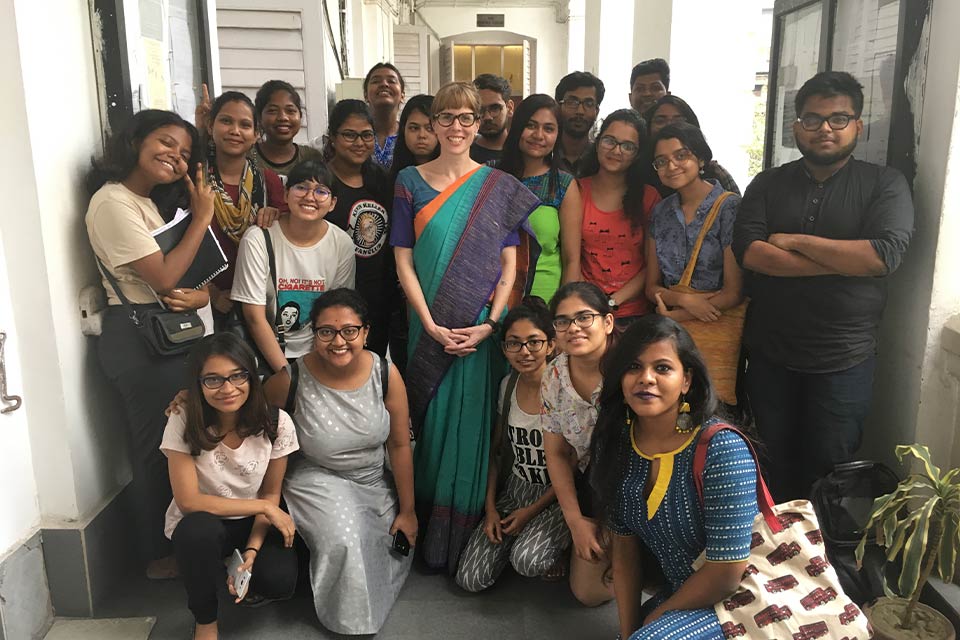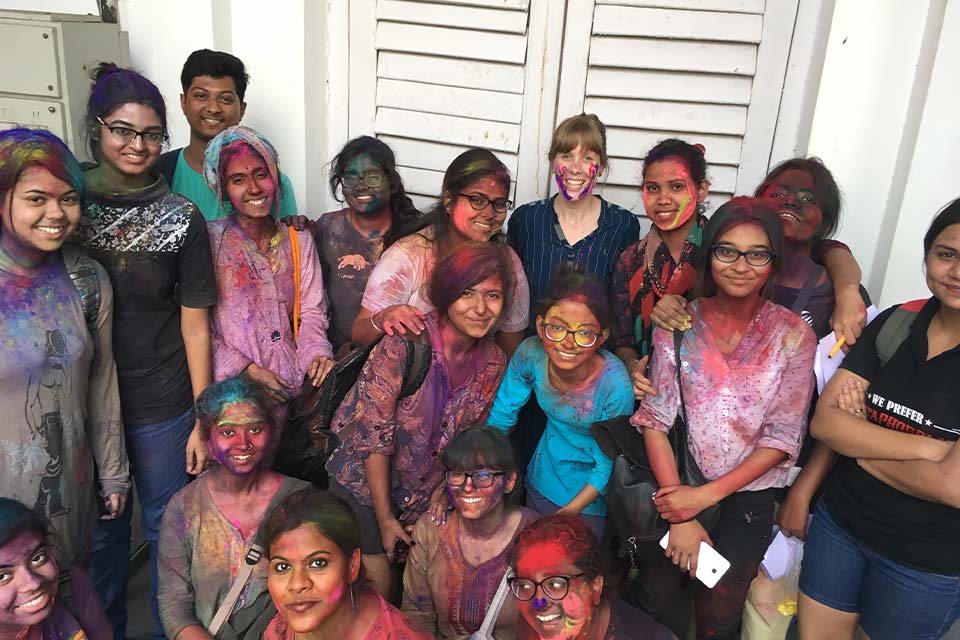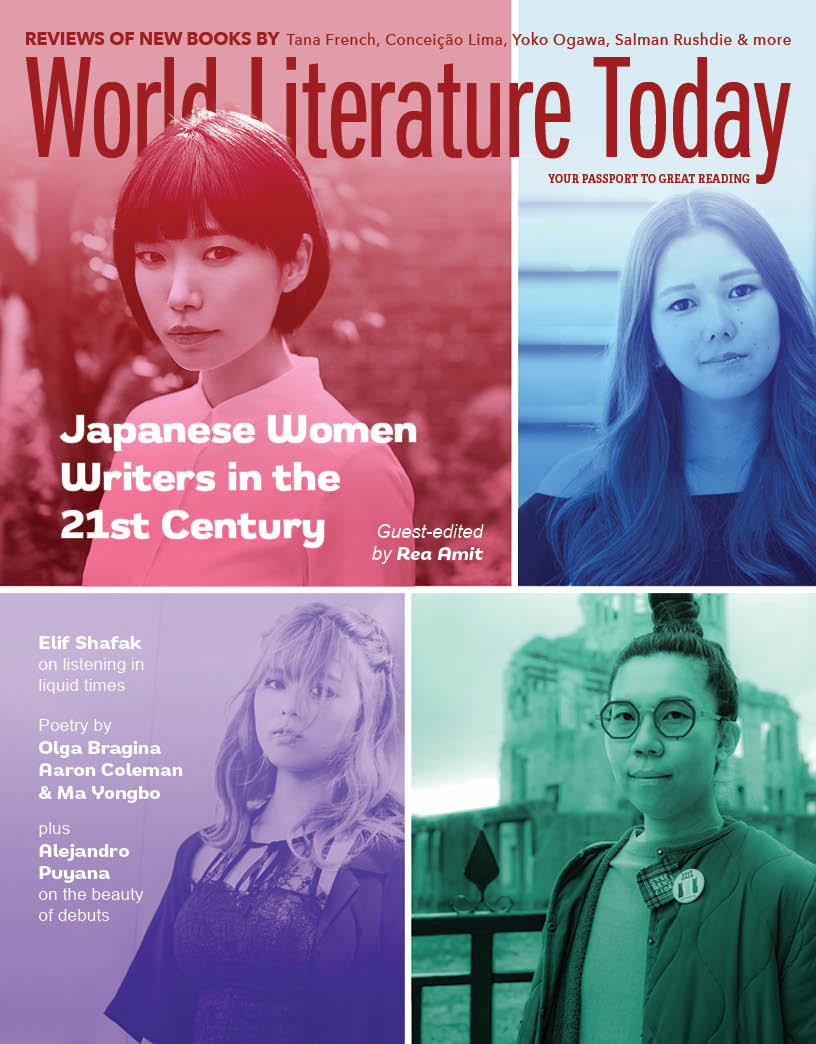Two Tin Trunks

An American teacher on a Fulbright in Kolkata encounters a surprising flashpoint in a classroom discussion of concrete nouns.
In my earnest Ohio accent one student later likened to Taylor Swift’s, I asked the class what they’d eaten for breakfast. The warble of the ceiling fan ricocheted louder in the quiet, and I sensed, not for the first time, a collective puzzlement at my American informality. In the spring of 2019 I was living in Kolkata, India, on a research fellowship and teaching a writing class at Presidency University, where the students were far more accustomed to lectures on Lacan or the subaltern. That day, by contrast, we were talking—rather, I was talking—about concrete nouns, the stuff, at once cherished and banal, that we cook and carry, scrub and touch. The tactile things that fill our pockets and our days. Uncertain how our breakfast might matter in a college English class, however, the students kept quiet, looking at the floor or out the window or at each other.
Finally, a young woman named Gunja said that she’d eaten poori. Someone else then announced he’d had roti. While I stood, keeping track on the smeared chalkboard, the class relaxed, willing to name the lentils soaking in a bowl on their kitchen counters and the balls of dough rolled between palms to become flatbread. The slotted spoons their mothers used to drain the oil. The rice paddles left in the sink. And when I asked, next, for everyone to simply name one thing they saw or had with them, a swell of responses echoed. The cigarettes and Amitav Ghosh novels in their backpacks. The crows and coconut palms beyond the open wooden shutters of our classroom. The man pulling a cart piled high with tins of mustard oil along the street below.
The point of the exercise, I offered, was to explore both the poignancy and the relative ease of specifying the precise, everyday objects that, no matter how trivial, remained crucial to illustrating and thereby concretizing the rooms and roads and lives we inhabit. Whether we were writing for a neighbor across the lane or a reader who’d never been to Kolkata, all contexts and concepts, I offered, were oriented in the tangible.
Calling out, then, the blue jeans, the terracotta cups of roadside tea, and the tickets for the ladies’ car of the local train on which they depended each day, the students watched as a vivid portrait of the fulcrum between tradition and modernity, on which many young adults in India find themselves, emerged from our inventory. The blue jeans that were not simply pants but were, in fact, the source of this or that mother’s ire—the jeans, she’d hissed, just that morning, which had the neighbors talking. The Amitav Ghosh novel that wasn’t just a required text for college but a beloved, dog-eared book that embodied the haunted beauty of the city. The more specific the thing, in other words, the more evocative both its intimacy and its broader significance became. And after a month of courteous hesitancy, that afternoon marked the first shared classroom vivacity that, I thought, we all felt in our bones.

The students watched as a vivid portrait of the fulcrum between tradition and modernity, on which many young adults in India find themselves, emerged from our inventory.
So, I was surprised when a student named Sneha raised her hand to express her doubt. “To concretize” an experience or a memory, she explained, might be impossible. At stake, she said, was not only this age-old question of the limitations of language but also this potentially vapid sense of witness or empathy on the part of the reader. This sense of entitlement or mirage of access. Furthermore, Sneha continued, the expectation that everything could be reduced to or represented by a concrete noun seemed to her a trope of colonial dominance.
I was a white, American professor on a Fulbright in Kolkata, and “teaching writing” is a messy exchange in any context, especially in twenty-first-century India, where English is widely considered a class as much as a language. This was also Presidency University, formerly Hindu College, founded in 1817, and an elite, English-medium institution originally established exclusively for upper-caste Bengali men. At Presidency, we were inheriting and perpetuating all sorts of historic complexities. But despite what I hoped was my sensitivity toward the potentially thorny dynamics at play, I also didn’t expect for concrete nouns to become a flashpoint.
The effort of articulation, Sneha continued, not only across different languages, but also time and disparate cultural viewpoints, might, at best, flatten or misrepresent an experience And, at worst, she later elaborated, it could give a reader—in this case me—the false impression of having understood something far too dangerous or sprawling or unthinkable to ever be made lucid or comprehensible. Something like the horrors of Partition.
In 1947, following centuries of colonial oppression and neglect, the British cut new borders, violent and arbitrary, around the subcontinent. Across Punjab in the West and Bengal in the East, Hindus and Sikhs made their way toward a newly demarcated India, while Muslims migrated away from it. In the uncertainty and the upheaval, neighbors and strangers turned on one another, at once victims and aggressors, survivors and murderers. An estimated one and a half million people lost their lives, and more than fourteen million people lost their livelihoods, their homes, and their land, both citizens and refugees, strangers in a new country in which they did not belong yet had no choice but to remain.
Like many students in the class, all of whom were born in the late 1990s, Sneha introduced herself in relation to Partition and as a fourth-generation survivor. When it came to trying to “concretize” the suffering and devastation of Partition, Sneha later wrote, she disputed my implication that such biblical bedlam or the plight of refugees over newly wrought borders could ever be—in her words—“understood as seamless(ly) as tea and biscuits.”
*
The following week Sneha sat at my desk during office hours. Studious and thoughtful, with shoulder-length black hair, often tied back in a low ponytail, she wore glasses and a delicate, silver wristwatch that slid, loose and dangling, along her narrow wrist. Holding a stack of books to her chest, Sneha fiddled with her watch while telling me that her mother had just unearthed, for the first time in anyone’s memory, two tin trunks that accompanied her great-grandparents and extended family during Partition, when they’d fled their ancestral home in East Bengal and which contained two red diaries that her grandmother, then in her late teens, had kept upon her arrival in Kolkata. Sneha knew that she would write about those diaries for our class. The question was how.
At first glance, the essay Sneha eventually did write was about her grandmother, how she and Didun, the Bengali diminutive for one’s mother’s mother, had always been inseparable, sharing a bed, a kitchen, and a “future.” But the real point of Sneha’s essay was to reject my emphasis on concrete nouns. “If I were asked to concretize the existence of those trunks,” Sneha wrote, “their genealogy, for lack of a better word, the history they tow along in wake—an exercise that has often found favour with our professor . . . I would, most definitely, be incapable of delivering upon that one term, ‘concretize.’ What do I concretize? From where do I concretize?”[i]
*
Of her work with the descendants of Partition survivors, oral historian Aanchal Malhotra describes that “connections to these lived traumas and histories [go] well beyond a surface telling into something . . . intrinsically theirs.”[ii] Sneha was raised on her grandmother’s recounting of East Bengal monsoons, of the banyan trees and lightning, the memories already her own, even if Sneha wasn’t born for another fifty years. And I wondered if she resisted not only the concept that an experience could be reduced to what was carried across the border or what was left behind, but the notion the relevant particulars had ever been external to begin with.
“She is the woman who catalogues the cups of rice needed to feed a family of twenty in post-Partition Kolkata,” Sneha wrote of her grandmother. “She was the woman who knew the ways in which vegetables could be boiled easier, given that Kolkata’s water was harsher than Mymensingh’s.” With rice and vegetables and gas for cooking, Sneha quoted the diaries to sketch a clear, if partial, indication of what this young woman had done with her hands and her hours. And in renouncing the concrete while also utilizing it, Sneha seemed to protect her grandmother’s recollections, in a way the land and its people had not been protected, from cleaving and separation. From a further dismantling into disparate parts. Udbaastu is Bangla for “uprooted” person, and in her essay, Sneha considered this juxtaposition. Did recording the weight of fish and the cost of oil stabilize that uprootedness or conceal it?
Did recording the weight of fish and the cost of oil stabilize that uprootedness or conceal it?
*
Sneha’s uncertainty stayed with me long after I returned to the US, and in 2021 I was invited to participate in a roundtable discussion on the “Politics of Untranslatability,” hosted by the British Centre for Literary Translation. I’m not a translator, but I agreed to participate in order to invoke Sneha’s doubt, to grapple with it, publicly, hoping to deepen, rather than solve, her misgivings.
I emailed Sneha then, to ask permission to quote her essay and cite her ideas. Writing back at once, she was as humble and generous as ever, still addressing me as “Ma’am.” Of course, she said. She’d be honored. Sneha was earning her MA then, though because of the pandemic, her classes remained remote. Still, she was optimistic: “I’ve been telling our juniors about your classes,” she added. “And believe me, your advice to write concretely has done wonders for me.”
Beaming alone at my laptop, I felt an almost electric bolt of synchronicity from ten and a half time zones away. More than any student I’d ever taught, Sneha had asked what I can only describe as the most difficult, most essential, most elusive questions about reading, writing, and the construction of any narrative. And yet, for all her deft opposition to the notion of what could—or could not—be made concrete, Sneha had also taken the work of the class to heart.
We emailed back and forth a bit, with Sneha expressing her “fond memories” of our semester together as we acknowledged how much the world had changed since our class. My husband had been sick with Covid in New York City in the spring of 2020. Her family had been sick with Covid in Kolkata in the spring of 2021. We were relieved to know the other had made it through. I was hoping to come to India that summer, I said, and we planned to see one another then.
In July 2022 I did return to Kolkata. Early on my second morning, jetlagged and restless before dawn, as a rainstorm seethed outside, I reached under the mosquito net for my phone. Another former student had messaged me during the night, I assumed, because we were also arranging to meet. “I have some bad news,” the email said instead. A few days earlier, Sneha had died from complications of Covid.
*
“As a writer,” Arundhati Roy once reflected, “I have often wondered whether the attempt to always be precise, to try to get it all factually right, somehow reduces the epic scale of what is really going on. Does it eventually mask a larger truth? I worry that I am allowing myself to be railroaded into offering prosaic, factual precision when maybe what we need is a feral howl.”[iii]
Not dissimilarly, between facts and howls, the descendants of Partition survivors often describe the haunted silence in which they were raised, yearning for evidence and information, while survivors themselves recount that their reticence was intended to shield their children and grandchildren from what they had endured. “What is important to note,” Malhotra explains of the younger generations, “is that this isn’t the language used to remember the experience of Partition, but the language used to remember the recollection of the experience of Partition.”[iv]
Between facts and howls, the descendants of Partition survivors often describe the haunted silence in which they were raised.
While obviously not comparable, I do think that in the wake of the coronavirus pandemic, we struggle to identify or to name even some of what’s been lost, as if to do so would make that emptiness hollower. As if, in the compulsion to leave the house and leave behind all those blurry, weary years of isolation and illness, we have yet to articulate either the language of experience or the language of recollection.
In that global absence, compounded by Sneha’s absence, I find myself wanting to tell her that she was right. That there are no tea and biscuits. Whether we are invoking the million and a half lives lost during Partition or the more than six million lives lost due to Covid or Sneha’s singular and radiant wisdom, nothing factual or precise comes close to reflecting the fear that transpired or the suffering that still reverberates. Grief, like monsoon, is a season. That season is also a howl.
Grief, like monsoon, is a season. That season is also a howl.
“Nari swadheenota jinishta ki?” In Bangla, this question asks: “What does freedom convey for women, at all?” It is one line Sneha pulled from her grandmother’s diaries that veered from vegetables and budgets. Inferring the “freedom” of a newly independent India, Didun crystallized, in four words, a predicament that might have defied concretization but was made all the more powerful because it was a question that, for women, has always been material and corporeal. With answers—or a lack of answers—that have always been embodied.

Since her passing, I have thought about Sneha every single day, imagining her grandmother alone in the bed they once shared and wondering, still and again, what freedom conveys for women at all. Sometimes I worry this sorrow is not my place. She was my student for only one semester. But in this, too, her impression on me reveals something between my focus on the concrete and her struggle against it. Between factual precision and negative space. Between nouns and howls.
A brief relationship, like an object, provides only a glimpse. A short interaction, like a concrete noun, is never the whole story. I wouldn’t want to imply otherwise, but nor would I want to overlook the magnitude of her life. When I first read Sneha’s essay, I was struck by what, as Malhotra elucidated, was “intrinsically” hers. Now, when I reread the same essay, I understand that, while never intrinsically mine, something has become a part of me, nonetheless. Metabolized into how I think and why I read and what I carry. Something I’ll hope to share as it was shared with me. Something of her heart and memory now inseparable from my own—not concrete and yet palpable all the same.
Kolkata
[i] Sneha Chatterjee, “Turmeric, Fish, Didun and I” (unpublished essay, April 2019).
[ii] Aanchal Malhotra, “Literary Lineage: Excavating a Linguistic, Physical, and Emotional Vocabulary of Partition,” Desibooks.co, May 10, 2022.
[iii] Arundhati Roy, My Seditious Heart: Collected Nonfiction (Haymarket Books), 510.
[iv] Malhotra, “Literary Lineage.”











